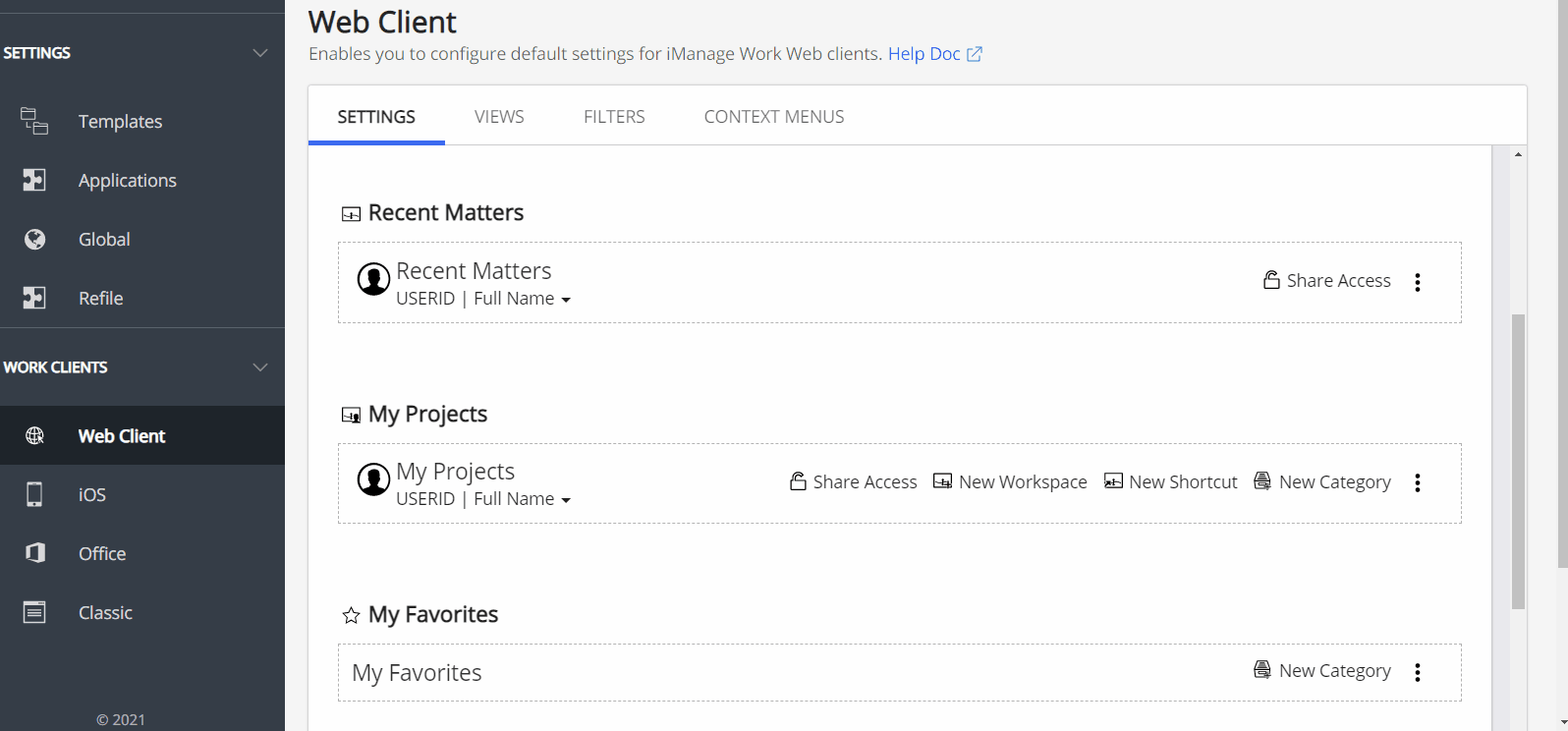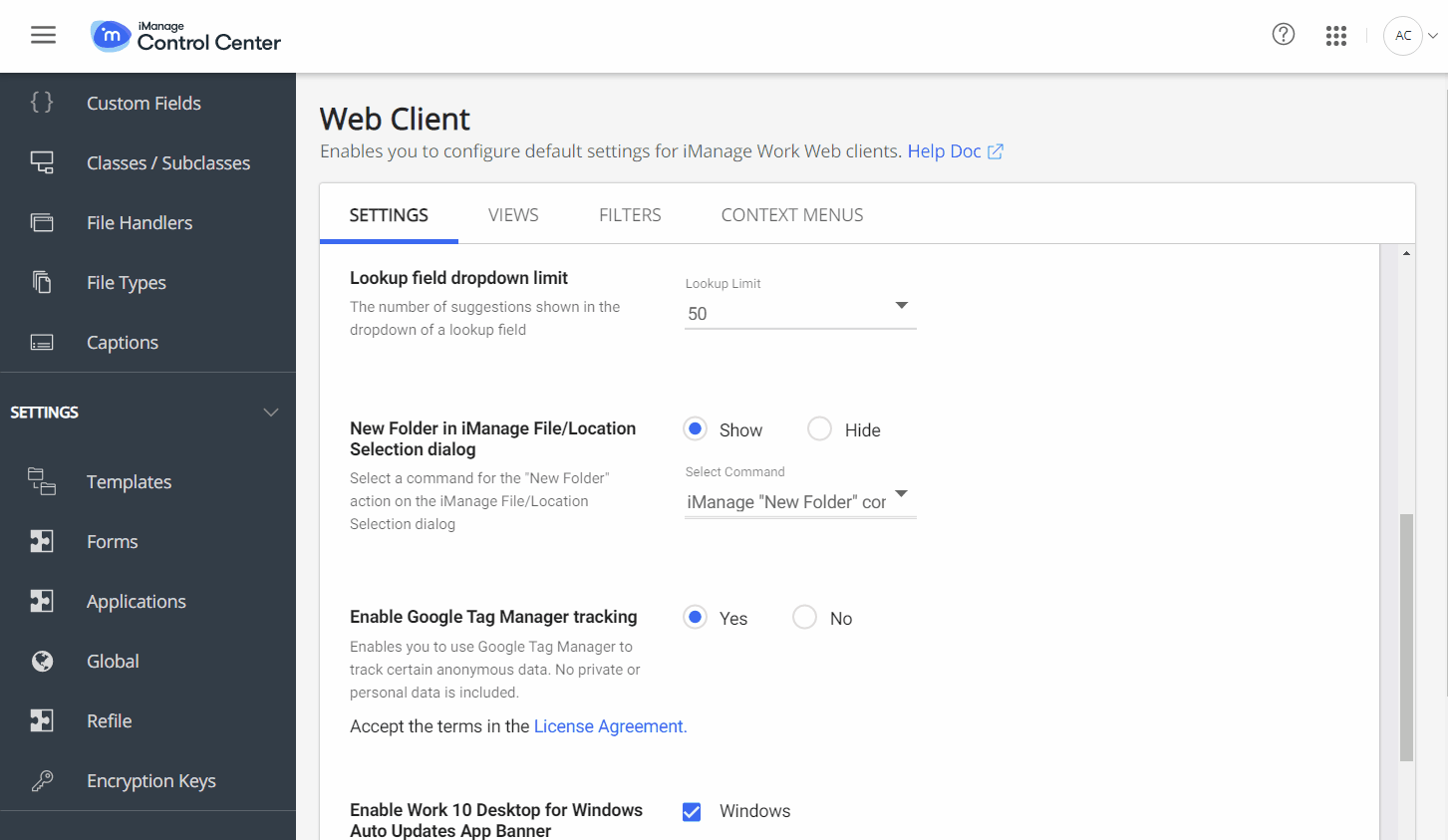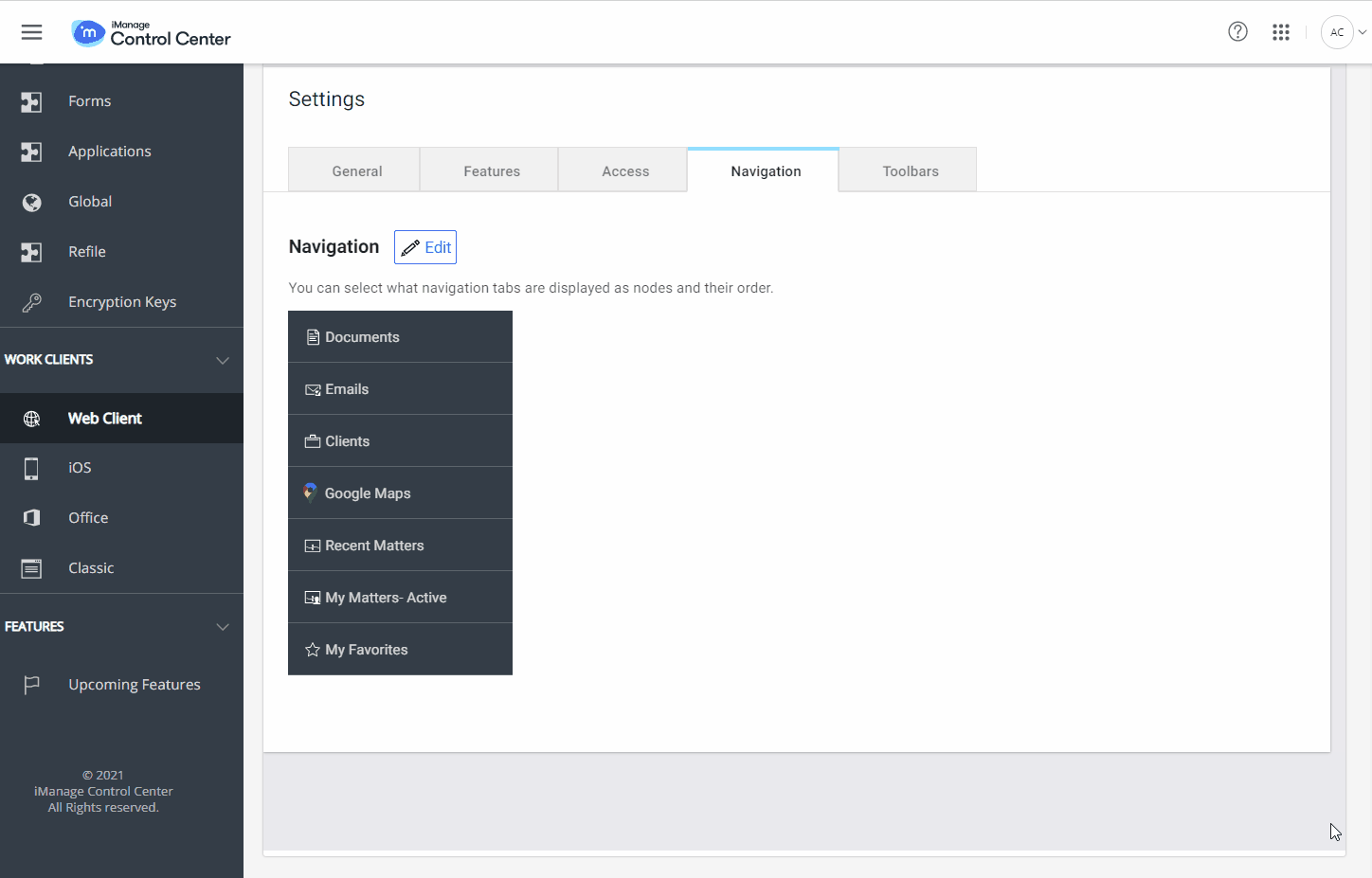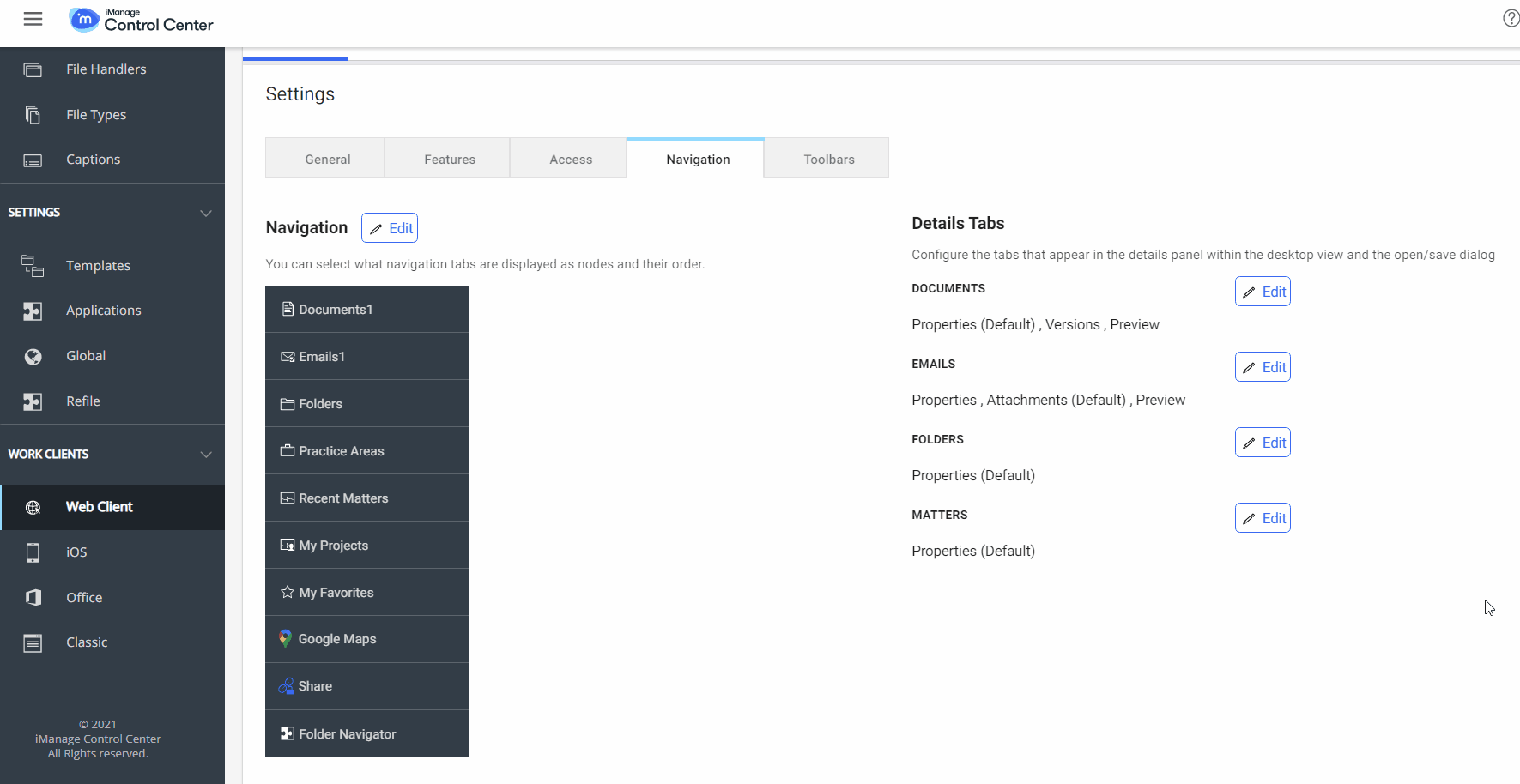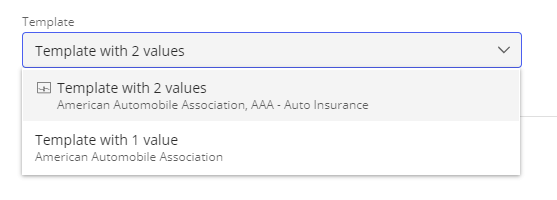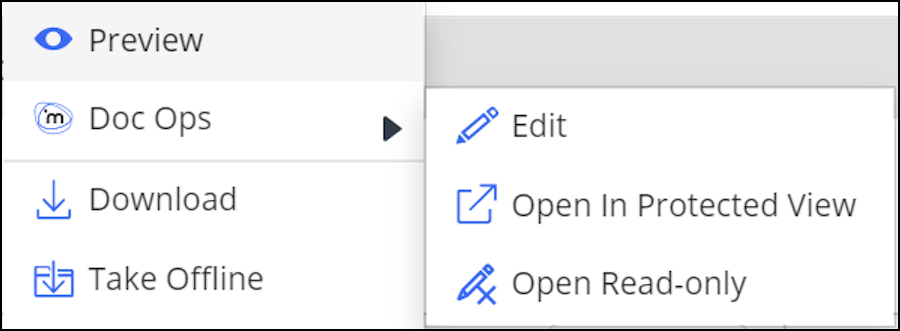November 2021
This update includes all enhancements provided in previous updates.
Integration with Microsoft Office for the web
iManage Work is now integrated with Microsoft Office for the web. With this integration users now create, view, edit and co-author Microsoft Office files (Word, Excel, and PowerPoint) directly in iManage Work even if they do not have Microsoft Office installed.
Users must have a valid Microsoft 365 license to use Microsoft Office for the web.
To enable this functionality, refer to Integrating iManage Work with Microsoft Office for the web.
October 2021
This update includes all enhancements provided in previous updates.
Enhanced security for virtual accounts
This update includes several improvements to increase and enhance the security of virtual user accounts in iManage Work. To authenticate, users with virtual accounts use the sign-in credentials stored and managed within iManage Work.
NOTE: These enhancements do not apply to enterprise user accounts in iManage Work. These accounts authenticate using SAML or OIDC single sign on with an independent Identity Provider (IdP). For enterprise user accounts, all password security and password management is managed directly by the IdP.
For more information about these enhancements, refer to Users.
Password complexity
Passwords must now contain at least 12 characters, including:
one uppercase letter,
one lowercase letter,
one number or special character from the following list:
*().&-_[]`~|@$%^?:{}!',/\#+<>;"= (including the space character)
Users see these requirements when they create their password for the first time or when they update their password.
Users are provided responsive tips to guide them when creating a new password.
Expired passwords
A user's password now expires 90 days from the date when it was created or last changed.
If the user's password has expired, they are automatically prompted to change their password during the sign-in process.
Users can also proactively update their password using the new Change Password option available in the user profile menu in iManage Work 10 Web or iManage Control Center.
NOTE: This menu option in Work Web is scheduled to be available on Nov 30, 2021.
To determine the last time a user's password was changed, administrators can view the Password Settings in the user's detail page.
Administrators can optionally disable password expiration for a user in iManage Control Center using the Password expiration option in the Create user or Edit user dialog box.
NOTE: As a best practice, disabling password expiration should only be used for automation or similar use cases where an expired password may disrupt a workflow. In these instances, password changes should be automated through the iManage Work Universal API.
Email notifications
iManage Work administrators can now send a welcome email directly to a user when creating the user in iManage Control Center. This email prompts the user to create a password for their new account.
An administrator can also send an email to a user when the administrator requires the user to change their password.
For security reasons, the link provided in the email to create or update their password remains valid for three hours. If the user does not take action within three hours, the link is deactivated, and an iManage Work administrator must resend the email to the user from iManage Control Center.
Failed sign-in attempts
iManage Work now limits the number of times a user can enter an incorrect user name or password when signing in.
After five failed attempts, the user account is temporarily locked for 15 minutes and the user is prevented from signing in for a period of 15 minutes.The user receives an email notification of the temporary lock out.
After 10 total failed attempts, the user account is locked again. The user receives an email notification, and directs them to contact their iManage system administrator for assistance.
In either case, the user must contact an iManage Work administrator to unlock the account within iManage Control Center.
New capabilities for administrators
iManage Work administrators can now perform the following in iManage Control Center:
Filter the list of user accounts to see which are currently locked, and quickly unlock these user accounts.
Send an email to one or more users to change their password. These users must enter their previous password, and create a new password in order to authenticate and resume using iManage Work.
Enhanced experience with static asset delivery
Static content used by the Work Web application, such has icons, images, HTML, JavaScript and CSS can now be loaded from from the user's nearest Microsoft Azure Content Delivery Network (CDN) point-of-presence (POP) location, providing users a richer and faster experience. This option is disabled by default.
NOTE: Customer content stored within Work is never placed on any CDN and will only ever be hosted from the data center to which it was uploaded.
Administrators can enable this feature using the following setting in iManage Control Center by browsing to Work Clients > Web Client > Settings > Features.
TIP: To test this setting before enabling it for all users, include the toggle_cdn=true query parameter in any Work Web URL, for example:
https://cloudimanage.com/work/web/r/recent-documents?exclude_emails=true&activity=edit&scope=ACTIVE,SECONDARY&p=1&toggle_cdn=true
For more information about this setting, refer to Web Client > Settings.
Updated Navigation Pane
In this update, the Encryption Keys option is renamed to Library Encryption in the Control Center navigation panel.
Full encryption key rotation
This update provides improvements to management of content encryption in iManage Work when using customer managed encryption keys (CMEK). These improvements provide additional protection from data breach or data destruction.
Content in iManage is encrypted with a hierarchy of three separate keys:
File encryption key: used to encrypt the file streams.
Library encryption key: created automatically upon library creation and when a primary key is applied to a library. This key is used to wrap the file encryption key,
Primary encryption key: stored in Microsoft Azure Key Vault. This key is used to wrap the library encryption key.
Previously, when a new primary encryption key was applied to (activated on) an iManage Work library, only the library key was rewrapped with the new primary key.
With this update, when a new primary key is applied to a library, a new library key is automatically generated, wrapped with the new primary key, and then used to rewrap all key files. This operation performs a 'full rotation' of the encryption keys: replacing the old primary key, generating a new the library key, and then unwrapping and rewrapping all file stream encryption keys.
Once a new primary key is applied to a library, the progress of the key rotation is shown in iManage Control Center.
For more information, including definitions of the different key statuses, refer to Library Encryption.
August 2021
This update includes all enhancements provided in previous updates.
Customize toolbar actions
iManage Work toolbars can now be customized in this update. Administrators can re-order, remove, group or add custom toolbar actions for containers like Recent Matters, My Matters, Workspace, Folder and so on. All available actions can either be shown as commands along the top toolbar or, be placed under the action menus. When the available space in the toolbar reduces for the added actions, they are responsively added to the action menu.
To customize toolbars in iManage Control Center, browse to Web Client > Settings > Toolbar.
NOTES:
The toolbar kebab menu actions for Folders or Matters continue to reference their respective context menus until the toolbar actions are customized.
Toolbar customizations in iManage Control Center apply to iManage Work Web, Work Panel & mobile views.
The Upload Folder action is not supported in iManage Work Panel. To upload a folder from Work panel, drag-and-drop a folder into a workspace or another folder.
Customize workflow for New Folder creation
Administrators can now show or hide the option to users the ability to create a new folder. Administrators can also choose a custom command (provided by a third-party tool) to create a new folder in the iManage File/Location Selection dialog. This allows administrators to define a custom workflow for New Folder creation from both Work Web and File/Location Selection dialog, based on organizational requirements.
In iManage Control Center, browse to Web Client > Settings > Features > New Folder in iManage File/Location Selection dialog.
Organize nodes in the side navigation panel
Administrators can now re-order, show or hide the nodes displayed in the side navigation panel in iManage Work. To customize the navigation panel in iManage Control Center, browse to Web Client > Settings > Navigation. These customizations are also displayed in mobile views.
Third-party extensions can also be enabled or disabled as nodes in the side navigation panel. To configure these extensions, refer to the iManage Work Web SDK Guide.
NOTE: Extensions can be configured to selectively appear or be hidden in the Mobile view or Work navigation panel in Microsoft Outlook.
Ability to configure the Details panel
Administrators can now configure the default tab shown to users in the Details panel, and also set the order of the tabs (including custom tabs) that appear.
To configure the Details panel, browse to Web Client > Settings > Navigation > Details Tabs.
Custom tabs in the Details panel can also be invoked through a context menu, which can be configured as part of the custom tab configuration and can be managed by the administrators in the context menu configurations.
June 2021
This update includes all enhancements provided in previous updates.
Control the creation of required folders from template
Administrators now have finer control over the creation of folders from a workspace template.
Users often collaborate on matters across departments. For example, a litigation matter may need some tax advice, so the tax attorney needs to create some relevant tax folders to store their documents. They can easily create these folders by selecting the appropriate workspace template, such as a tax template. When the tax attorney selects a different template, iManage Work automatically creates all of the folders that are marked as Required or Workspace Creation from the selected template, even though the tax attorney may not need or want all of the folders created.
This could result in the creation of a number of extra unused folders in the workspace.
iManage Control Center now provides an option to control which folders are created in this scenario.
All required folders must be added: When a user selects a different template in the New Folder dialog, iManage Work creates all folders and subfolders from the newly-selected workspace template. This is the default option.
Add root level required folders only when the selected template was used to create the workspace: When a user attempts to create a new folder using a template that was not used to create the workspace, the user is given the option to select which root folders are to be created. This is the case even if the root level folder are configured as Required or Workspace Creation folders in the newly-selected template.
There is no change to the behavior of subfolders. If they are marked as Required or Workspace Creation in the template, they are automatically created, regardless of this setting.
To access this setting, browse to Settings > Global.
For more information about this capability, refer to Global settings.
Inherit empty values from parent during refile
Administrators now have the capability to configure how metadata changes are applied when the workspace has no value set for a property.
By default, the Refile Service applies metadata values to the folders and documents within it to ensure consistency. In the scenario when the workspace has no value for a given field, it updates all folders and documents within the workspace, potentially removing metadata information that is present in these items.
A new setting enables you to prevent the Refile Service from removing the metadata values from the child items in this scenario.
To access this capability, browse to Settings > Refile. Select a library to open the Setup Refile dialog.
The Inherit empty values from parent setting is available on the Metadata section of the dialog.
For more information about this capability, refer to Configuring Refile.
May 2021
This update includes all enhancements provided in previous updates.
Manage upcoming features
Administrators now have the capability to enable or disable new features for evaluation and testing. When key new features are introduced in your iManage environment, they are listed in the Upcoming Features page in Control Center (Settings > Upcoming Features) for a period of time, typically 3 months. Each feature is disabled by default, and can be enabled for users for evaluation, training, or user acceptance testing purposes.
When the testing period ends for an upcoming feature, the feature is automatically enabled for all iManage users, at which point it is removed from the list features on the Upcoming Features page in Control Center and can no longer be enabled or disabled.
To access this capability, browse to Settings > Upcoming Features.
For more information about this capability, refer to Upcoming Features.
Show or hide all templates in template selection menu
NOTE: This setting is available only if it has been enabled in your environment. For more information or to request this capability, contact your Cloud Services Manager.
When it is made available in your environment, the Allow admins to hide "Other Templates" feature appears in Control Center under Settings > Upcoming Features, where you may enable or disable it during the defined testing period.
For more information, refer to Upcoming Features.
In previous releases, when users created a new folder within a workspace, they were allowed to see and select from a list of all available templates configured in iManage Work. In this update, a new setting has been added to display only those templates that match the configured Match fields for the workspace.
This prevents users from choosing a template that does not align with your company's business processes, and reduces the complexity for users as they are no longer shown a potentially long list of available templates when creating a new folder.
To configure the Show all templates in template selection menu setting, browse to Settings > Global.
For more information about this setting, refer to Global settings.
Q1 2021
For more details about the Q1 2021 (10.3.3) update, refer to the Service Update: iManage Work in the Cloud - Q1 2021 article on the iManage Help Center.
Refile Service enhancements for multi-reference documents
Documents referenced in multiple locations (multi-reference documents) in iManage Work present a unique challenge when the Refile Service updates the document's properties. Previously, the metadata or security properties applied by Refile Service could come from any number of different locations where the document was referenced. When the metadata or security properties were updated in any of these locations, the Refile Service automatically applied the properties from the location that was last updated.
In this release, iManage Control Center now enables administrators to configure the behavior of Refile Service when refiling multi-reference documents. Two new options are provided based on the chronological order in which the document was referenced to a location:
Oldest location
Newest location
You can also configure the Refile Service to skip multi-reference documents entirely by disabling the Refile multi-reference documents option.
These new options give you control over how metadata and security is applied to documents that are referenced in multiple locations during a refile.
TIP: To determine the order in which a document was referenced to its locations, view Where Used or Where Filed in the Properties panel in iManage Work. The locations shown are listed from oldest to newest, based on the time at which the document was added to this location.
NOTE: This time-based ordering applies only to when the document was added to the immediate parent location. For example, if a document is added to a folder, and the folder is then moved to a different workspace at a later date, the order shown in Where Used does not change.
Configuring Refile Service
To configure the Refile Service settings in iManage Control Center, browse to Settings > Refile, then select any of the available libraries to view and edit the Refile options for the selected library.
The new configuration options are displayed under the Documents section.
For more information, refer to Multi-reference documents.
Interface updates
The Refile settings table now displays the Multi-reference documents setting for each library.
The Setup Refile wizard and the Refile details page are updated as shown:
Document Exclusions is now displayed as Documents.
Workspace Exclusions is now displayed as Workspaces.
Update applications
iManage Control Center now supports the ability to update existing applications. This new capability updates the application and preserves any configuration settings (authentication, access, and so on) from the existing application.
In any existing application, the new Update package menu option is now available.
Select Update Package and proceed through the steps of the Update Package wizard to update the application.
For more information, refer to Updating an application.
Create sub-menus in iManage Work menus
iManage Control Center now allows you to create sub-menus within the context menus in iManage Work. This enables you to group and organize menu actions to fit your users' needs.
These menu actions are displayed in the iManage Work Web client and the iManage Work panel in Microsoft Outlook in the following locations:
Context menus
Document Preview toolbar
Multi Select toolbar in the List/Grid view
Mobile view
Sub-menus are configured in iManage Control Center by browsing to Work Clients > Web Client > Context Menus.
The new Create Sub-menu option is provided at the bottom of each menu.
For more information, refer to Context menus in the iManage Control Center online help.
Document search by checked out users
iManage Control Center now supports the ability to search for documents that are checked out by a specific user or users.
This capability enables you to quickly locate and take action on all documents that are currently checked out by the specified user(s). This is useful when locating documents for a departing user.
Changes to New Workspace dialog functionality
The updated New Workspace dialog introduced in iManage Work 10.3.2 displays No results found when a user attempts to create a custom metadata value during the creation of the workspace.
To achieve the same functionality provided in the old dialog, an iManage Work administrator must perform the following steps:
Browse to iManage Control Center > Global.
Select Edit.
Locate the Allow to Create Metadata setting, and select the drop down menu to define which custom fields allow metadata creation. By default, no custom fields are selected.
Select Save.
For more information, refer to the New process to add custom metadata values in the iManage Work New Matter dialog advisory on iManage Help Center.











